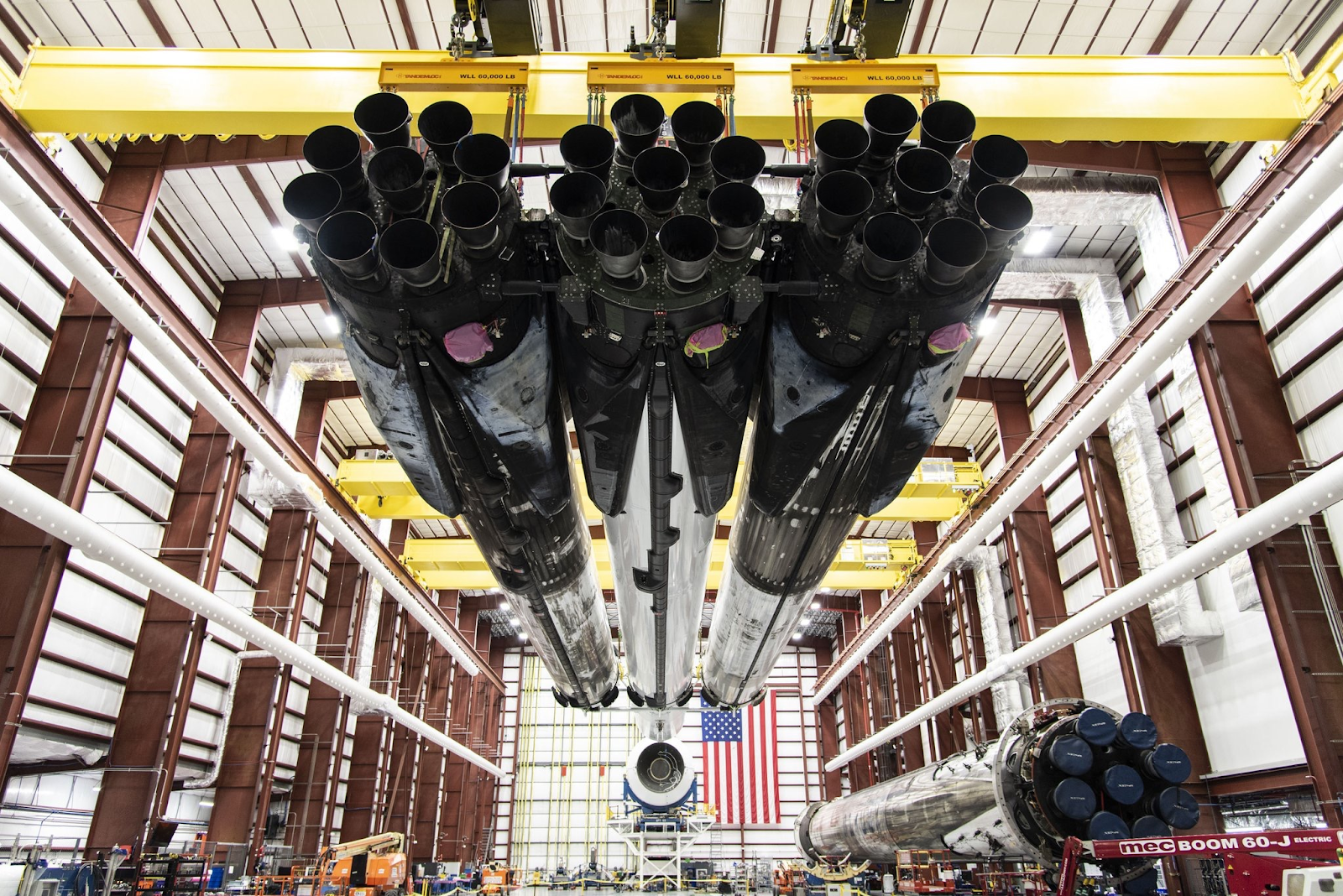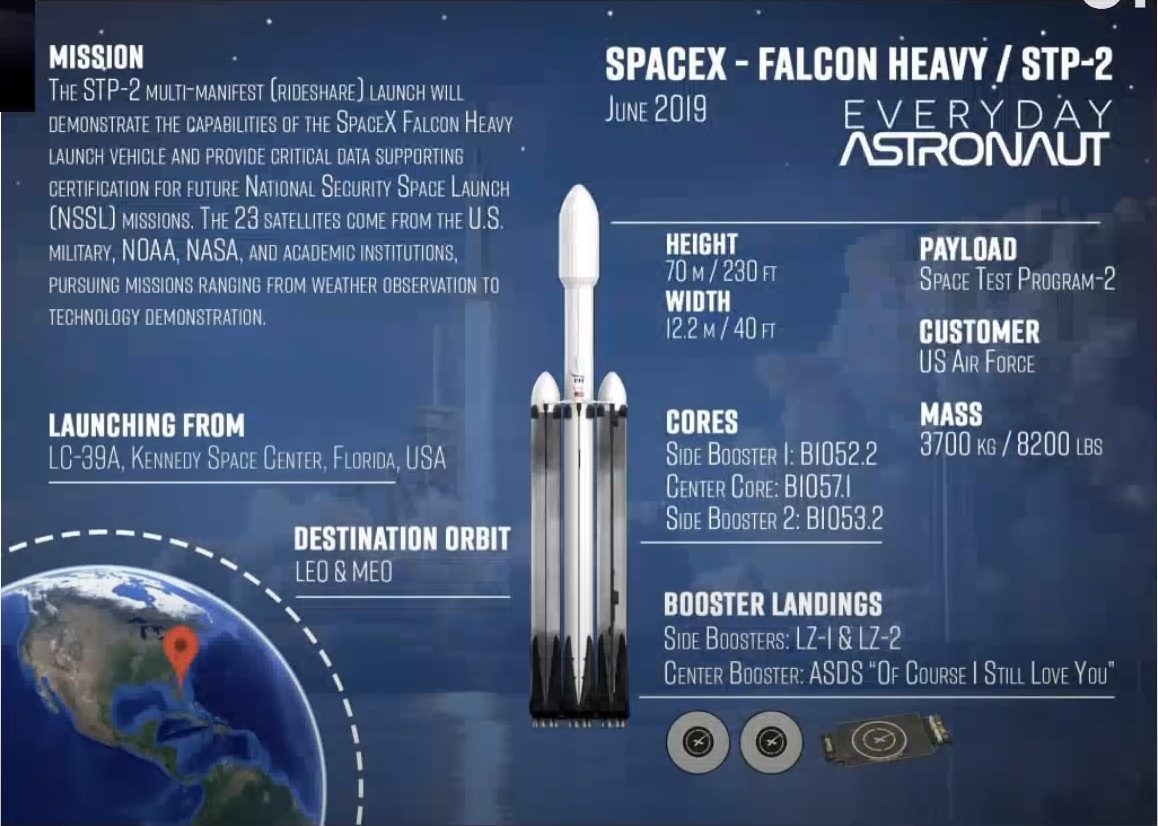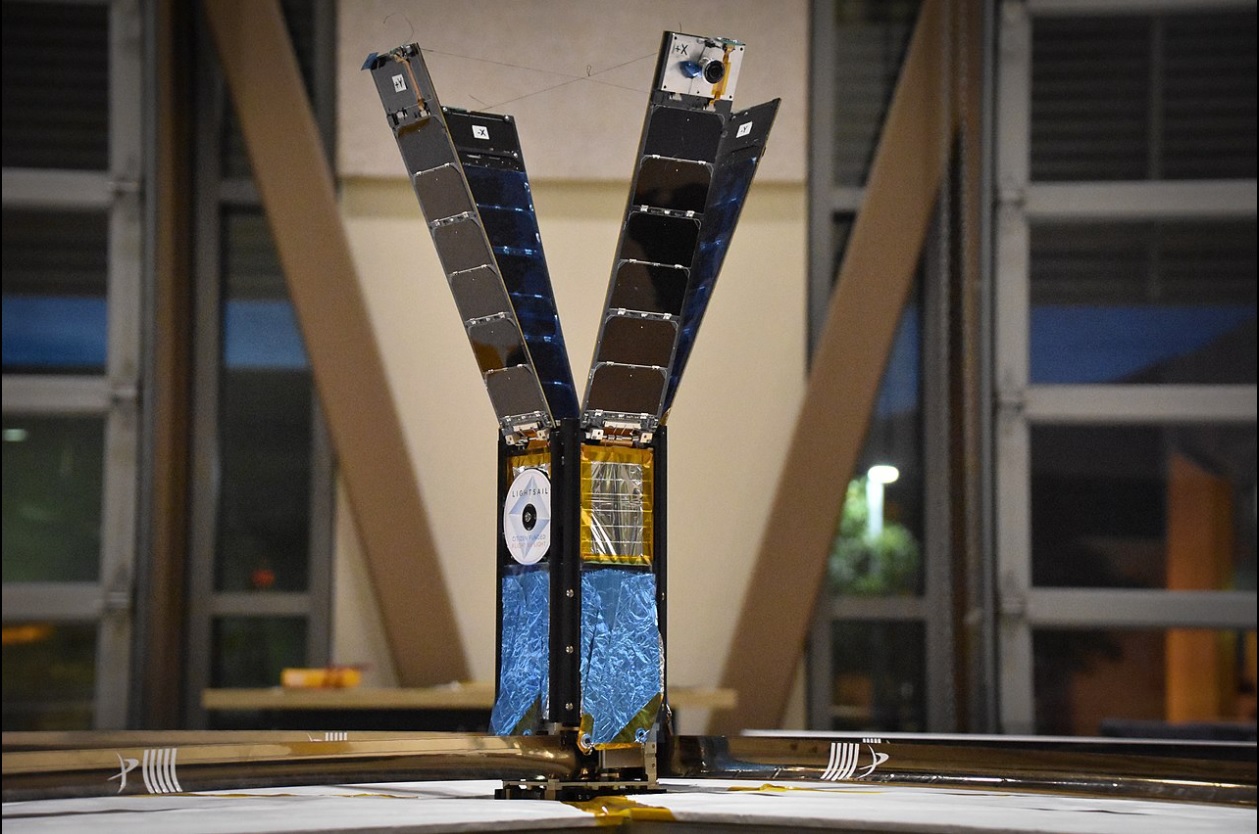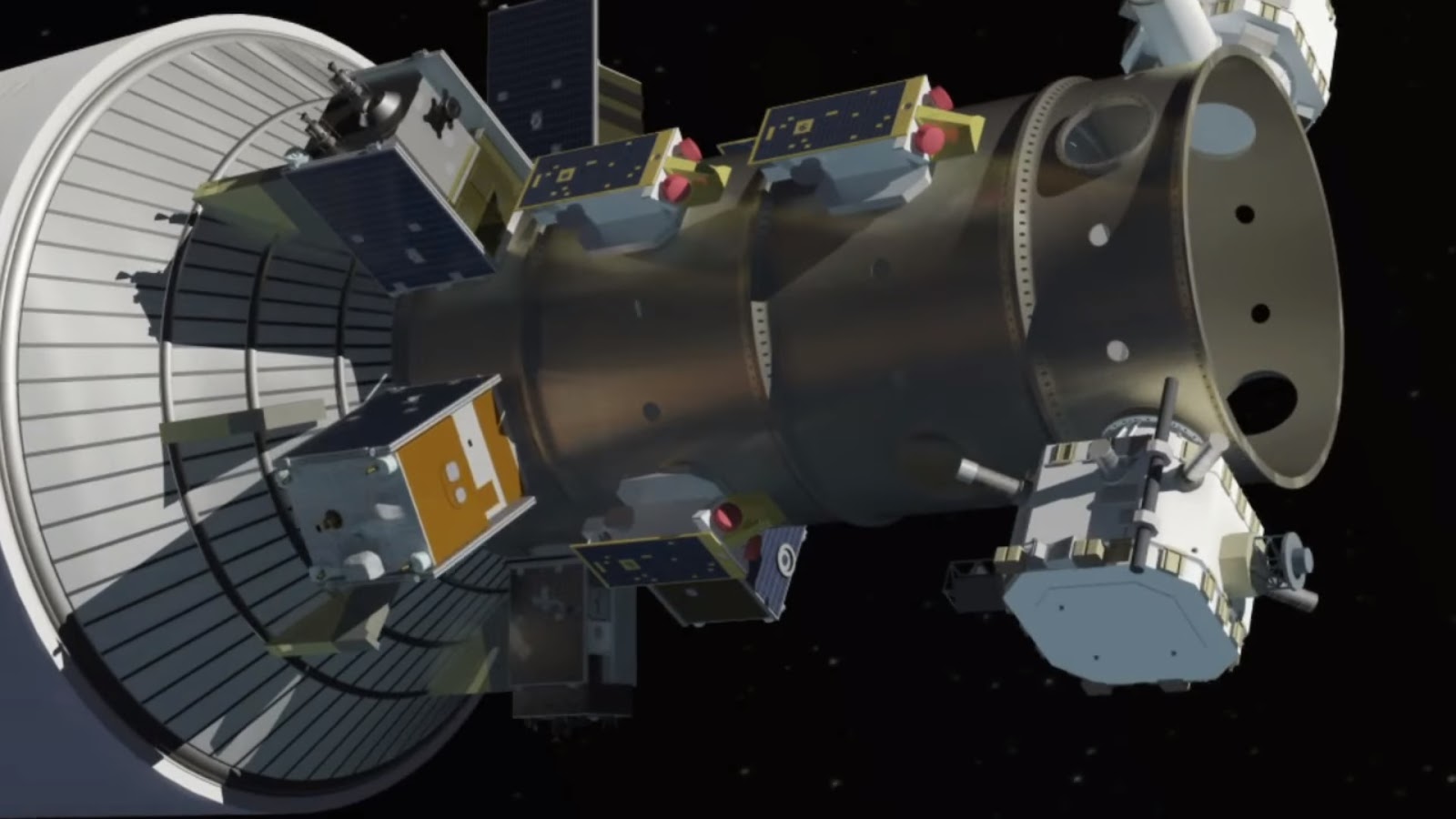
Falcon Heavy preparing to mate with fairing in SpaceX’s hangar at LC-39A → spacex.com/stp-2 If anyone asks, I’m just hangin out before my flight and waiting for the TEL to come pick us up
Mission Rundown: SpaceX Falcon Heavy - STP-2
Written: January 6, 2021
Lift Off Time | June 25, 2019 - 06:30 UTC - 02:30 EDT |
Mission Name | STP-2 - Space Test Program 2 |
Launch Provider | SpaceX |
Customers | U.S. Department of Defense NASA NOAA |
Launch Vehicles | Left Block 5 side booster B1052-2 Y- Falcon Heavy Block 5 Core Booster B1057 Right Block 5 side booster B1053-2 Y+ |
Launch Location | Historic Launch Complex 39A - LC-39A Kennedy Space Center at Cape Canaveral, Florida |
Payload | 12 Mini- Nano- & Microsatellites 12 CubeSats from various sources |
Payload mass | 3 700 kg ~ 8 157 pounds |
Where are the satellites going? | The satellites will be deployed in 3 distinct orbits, 2 Low Earth Orbits and the DSX spacecraft will be deployed in a Medium Earth Orbit. |
Will they attempt to recover the first stage and side boosters? | Yes - The side boosters have enough fuel to return to launchsite - The core booster is aiming for OCISLY. |
Where will the first stage and boosters land? | On OCISLY 1 236 km (771 miles) down range and Landing Zones LZ-1 & LZ-2 at CCAFS |
Will they be attempting to recover the fairings? | Yes - GO Navigator and GO Ms Tree will be participating in fairing catch attempt 1 346 km downrange |
Are these fairings new? | Yes - Type 2.2 lifeboat sized fairings - 34 x 17 feet with 8 ventilation ports and a heat resisting steel tip |
This will be the: Falcon Heavy is not a single stick launch vehicle so in order to reduce confusion only their single boosters are counted as Falcon 9’s regarding their landings The Falcon Heavy core booster didn't make it to OCISLY 1236 km downrange | – 3rd Falcon Heavy launch by SpaceX – 1st flight of Falcon Heavy core booster – 1st & 2nd re-flight of Falcon Heavy sidebooster – 18th SpaceX launch from LC-39A – 41st, 42nd & 43rd booster landings overall – 39th crash landing. soft, hard, deliberate, Ups... – 8th mission for SpaceX in 2019 |
Where to watch Where to read more in depth | SpaceX link Tim Dodd on Falcon Heavy 3 June 25, 2019 |
Launch debriefing (This is what happend) | - T-00:19:17 Hosts: T 00:00:00 T+00:00:48 T+00:02:33 T+00:02:52 T+00:03:34 T+00:03:43 T+00:04:08 T+00:07:18 T+00:08:22 T+00:08:45 T+00:09:40 T+00:11:10 T+00:13:06 - - - T+01:12:40 - T+01:13:51 - T+01:19:30 - - - - - T+02:06:58 T+02:07:42 - T+03:27:01 T+03:27:28 - T+03:34:22 T+03:35:53 | Pre Launch Run Down from 3:15 then Q&A SpaceX live feed at 14:06 Alex Siegel, Jessica Andersson and John Insprucker Liftoff at 33:27 - 06:30:00 UTC MaxQ at 34:15 (3 sec delay on downlink camera) BECO at 36:02 Booster release at 36:05 Boost back burn by boosters at 36:21 - 67 seconds MECO 37:03, stage separation 37:05 SES-1 at 37:12 Fairing separation at 37:37 Booster entry burn 40:48 by 6 Merlin 1D# for 20 seconds Landing burn 41:52 by 2 Merlin 1D# for 22 seconds SECO-1 at 42:15 and coasting Entry burn 43:10 by center core for 14 seconds Landing burn 44:40 by center core - failed Deployment 1 at 46:36 - T+19:23 - T+24:59 - T+28:52 - T+31:18 - T+34:05 - T+38:50 - T+43:54 - T+50:10 Replays, tweeting with Q&A between deployments and launch day offer merchandise at 1:27:40 SES-2 - SECO-2 gave a velocity boost from 25.070 km/h to 25.280 km/h in 22 seconds First fairing half caught by GO Ms. Tree 1:47:27 - The other half was damaged but salvaged Deployment 2 at 1:53:03 - T+01:21:54 - T+01:24:05 - T+01:27:13 - T+01:31:23 - T+01:34:36 - T+01:36:30 - T+01:39:53 - T+01:43:20 - T+01:46:13 Q&A with info, explanations from 2:19:10 Launch day offer on merchandise at 2:23:35 Rap up from Tim Dodd at 2:24:11 And watching SpaceX from 02:31:56 their video time SES-3 and SECO-3 gave a velocity boost from 25.352 km/h to 28.837 km/h in 30 seconds, apogee 6 000 km SpaceX is back for final MEO burn and deployment SES-4 and SECO-4 gave a velocity boost from 14.630 km/h to 20.046 km/h in 47 seconds, altitude 6.006 km Deployment of DSX at 1:53:03 Hats of to Tim Dodd |
One giant leap for… - …was just too far
SpaceX will be launching the Space Test Program 2 (STP-2) rideshare mission for the U.S. Air Force’s Space and Missile Systems Center on a Falcon Heavy rocket. This Falcon Heavy is composed of a new block 5 center core (B1057) and the two block 5 side boosters (B1052-2 & B1053-2) from the Arabsat-6A mission.
The launch window for this mission opens at 11:30 PM EDT on June 24, 2019 and is 4 hours in duration. The Falcon Heavy will be lifting off from Launch Complex 39A (LC-39A) at the Kennedy Space Center in Florida. After burning for about 2 and a half minutes, the side boosters will separate from the core booster and boost back to the launch site for a landing at Landing Zones 1 & 2 (LZ-1 & LZ-2).
The core booster will continue burning for another minute, before shutting down and separating from the second stage. The core booster will be landing approximately 1 239 km (771 miles) downrange on the Autonomous Spaceport Drone Ship, Of Course I Still Love You (OCISLY). The core booster crash landed and did not survive the impact.

Screenshot of Falcon Heavy mission view by Geoff Barret - The soddy side boosters have flown before
It took 8 months to make a deployment list
The unclear Payload
From Wikipedia it says that the STP-2 (DoD Space Test Program) payload was launched aboard a SpaceX Falcon Heavy on 25 June 2019 - 06:30:00 UTC.
Included was COSMIC-2, a cluster of six satellites, with a mass of 277,8 kg each. The primary role of the COSMIC-2 satellite constellation is to provide radio occultation data with an average latency of 45 minutes.
The six satellites were placed on an orbit with an inclination of 24 to 28.5 degrees with plans for them to move eventually to six separate orbital planes with 60 degree separation between them. The payload stack was integrated using an ESPA ring. Two ESPA Grande adapter rings were used to mount the six COSMIC-2 satellites beneath the upper payload adapter hosting the DSX payload and avionics modules. Arrgh Write it properly ESPA ring.
STP-2 also deployed a number of CubeSats as secondary payloads, including E-TBEx, PSAT, TEPCE, and 3 ELaNa 15 CubeSats. LightSail 2 is carried by the Prox-1 nanosatellite. Other satellites and payloads included Oculus-ASR nanosatellite, GPIM, and the Deep Space Atomic Clock. Another source of information is this article.

LightSail 2 after a boom deployment test
 Screenshot of artist impression of STP-2 payload mounted on ESPA rings with portholes
Screenshot of artist impression of STP-2 payload mounted on ESPA rings with portholes
There are 4 ESPA rings with 17 ports upon which a Minisatellite or CubeSat dispenser is secured. PPOD 1-8 deploys the first 11 CubeSat payloads.
Payload Pay Dirt
From the eo Portal Directory this article about the Deep Space Atomic Clock shows the precise loading manifest of STP-2, so now there is access to a more detailed Payload list, and an educational explanation of the use of atomic clocks in space.
First set of deployments consists of 10 small secondary CubeSat satellites that will be deployed into an elliptical orbit of ~300 x 860 km, inclination of ~28º.
OCULUS-ASR deployed from ESPA ring 1 port 1 of 5 in top view of PAF camera
OCULUS-ASR: Attitude and Shape Recognition Microsatellite - 70 kg - from MTU
OCULUS-ASR SPHERE: Deployed Attitude and Shape Recognition CubeSat- 2 kg - MTU
PPOD-1 have deployed DOTSI an unlisted CubeSat along with TEPCE
TEPCE 1&2: Tether Electrodynamics Propulsion CubeSat Experiment, a 3U CubeSat 3 kg
PPOD-2 have deployed FalconSat-7
FalconSat-7: a 3U CubeSat mission developed by the Cadets of the U.S. Air Force Academy
PPOD-3 have deployed ARMADILLO
ARMADILLO: a nanosatellite - 3U CubeSat from University of Texas at Austin, mass ~ 4 kg
PPOD-4 have deployed PSAT-2 and BricSat 2
PSAT-2: ParkinsonSAT, a student built 1.5U CubeSat of US Naval Academy - mass 2 kg
BRICSAT: a student built a 1.5U CubeSat of USNA (US Naval Academy) to demonstrate a µCAT
electric propulsion system and carry a ham radio payload
PPOD-5 have deployed the Prometheus CubeSat, another unlisted CubeSat
PPOD-6 have deployed E-TBEx A, the first of the tandem pair of CubeSats
E-TBEx A: Enhanced Tandem Beacon Experiment, a 3U CubeSats from SRI
PPOD-7 has deployed E-TBEx B, the second of the tandem pair of CubeSats
E-TBEx B: Enhanced Tandem Beacon Experiment, a 3U CubeSats from SRI
PPOD-8 has deployed CubeSats CP-9 “LEO” and StangSat
CP-9/StangSat: a joint 2U CubeSat/1U CubeSat experiment sponsored by NASA LSP
By seeing CP-9 “LEO” deployed, I suspect that PPOD 1-8 is a CubeSat dispenser mounted on top of DSX, which is mounted on ESPA ring 4 port 1 or Z+ who is in camera view.
The last set of CubeSat are developed under the ELaNa-15 program - Educational Launch of Nanosatellites run by the Launch Services Program (LSP) at NASA's Kennedy Space Center in Florida.
Second sets of deployments consist of 10 Mini- and Nanosatellites and 1 CubeSat, which will be deployed in a circular orbit at 720 km altitude and at an inclination of 24º.
Prox-1: Nanosatellite - mass 71 kg - Space Systems Design Laboratory at Georgia Tech
LightSail-2: Planetary Society, Nanosatellite 3U CubeSat - mass 5 kg - are deployed by Prox-1 who were deployed from ESPA ring 1 port ? of 5 out of view of PAF camera
NPSat-1: Nanosatellite - mass 86 kg from Naval Postgraduate School, Monterey, CA.
NPSat-1 where deployed from ESPA ring 1 port 2 of 5 in view of PAF camera
OTB-1: Minisatellite with NASA's DSAC - Deep Space Atomic Clock - millimeter accuracy?
OTB-1 where deployed from ESPA ring 1 port ? of 5 out of view of PAF camera
GPIM: Green Propellant Infusion Mission Minisatellite - hydroxylammonium nitrate (HAN)
GPIM where deployed from ESPA ring 1 port ? of 5 out of view of PAF camera
6 FormoSat-7/COSMIC-2 Satellites on ESPA ring 2 and 3 from NOAA and Taiwan’s NSO
COSMIC-2-5 deployed from ESPA ring 2 port Z+ who are in view of PAF camera
COSMIC-2-6 deployed from ESPA ring 2 port Z- who are out of view
COSMIC-2-2 deployed from ESPA ring 2 port Y- who are out of view
COSMIC-2-4 deployed from ESPA ring 2 port Y+ who are in view
COSMIC-2-1 deployed from ESPA ring 3 port Z- who are out of view
COSMIC-2-3 deployed from ESPA ring 3 port Z+ who are in view
Third and last deployment happens after two orbit raising and circulation burns made by the second stage to reach an elliptical MEO (Medium Earth Orbit) with a perigee of 6000 km and an apogee of 12000 km, inclination of 43º.
DSX: Demonstration and Science Experiments mission of AFRL Air Force Research Lab
SET 1 and 2 are DSX payload and avionics mounted on ESPA ring 4 port 1 and 3; Z+ and Z-
DSX payload where deployed with ESPA ring 4 mounted on port 1 Z+ in view of PAF camera
There is no longer something missing in this launch manifest. After searching 6 different sources, it’s now possible to find a more clear loading manifest and details about the 24 Minisatellites and CubeSats and their deployment order.
Other multi-satellite deployments have the same problem with being superficial. Only details about the CubeSats are lacking “Sorry. Nerd level 9 in progress.”
In the picture below, there are a pair of missing payloads called SET-1 and SET-2, which will replace the two Van Allen Probes. The Space Environment Testbed payloads should have had a recognizable mission name, but damn if I know which payload. Maybe there was room for two extra Minisatellites, but they got cut from the loading manifest.
Found them at last. It’s DSX on ESPA ring 4. Enjoy the picture. It’s at least “colorful”.
 The missing payloads is SET-1 and 2, who will replace the two Van Allen Probes - It’s DTX Arrgh
The missing payloads is SET-1 and 2, who will replace the two Van Allen Probes - It’s DTX Arrgh
Following orbital targets were identified by the NORAD space track. “Sorry. Nerd level 10.”
NORAD Name NSSC ID Type Country Period Incl. Apo Peri
44339 Prox-1 2019-036A NanoSat TBD 99.13 24.00 725 709
44340 NPSat1 2019-036B NanoSat TBD 99.12 24.00 725 708
44341 OTB-1 2019-036C MiniSat TBD 99.12 24.00 725 708
44342 GPIM 2019-036D MiniSat US 99.09 24.00 725 706
44343 Formosat/Cosmic-3 2019-036E PAYLOAD TBD 99.10 24.00 725 707
44344 DSX 2019-036F PAYLOAD US 316.92 42.21 12035 6005
44345 FH R/B 2nd stage 2019-036G Debris US 306.86 42.24 11936 5449
44346 OBJECT H 2019-036H TBA US 96.27 28.52 853 307
44347 OBJECT J 2019-036J TBA US 96.24 28.53 850 307
44348 OBJECT K 2019-036K TBA US 96.23 28.52 852 304
44349 Formosat/Cosmic-1 2019-036L PAYLOAD TBD 99.10 24.00 724 707
44350 Formosat/Cosmic-4 2019-036M PAYLOAD TBD 99.10 24.00 724 707
44351 Formosat/Cosmic-2 2019-036N PAYLOAD TBD 99.09 24.00 724 706
44352 ARMADILLO 2019-036P CubeSat 96.21 28.54 848 306
44353 Formosat/Cosmic-6 2019-036Q PAYLOAD TBD 99.09 24.00 724 706
44354 PSat-2 2019-036R CubeSat US 96.19 28.53 847 305
44355 BricSat-2 2019-036S CubeSat US 96.19 28.53 847 305
44356 OCULUS ASR 2019-036T NanoSat 96.15 28.52 847 301
44358 Formosat/Cosmic-5 2019-036V PAYLOAD US 99.09 24.00 725 705
44359 E-TBEX-B 2019-036W CubeSat US 96.14 28.52 847 300
44360 CP-9 LEO 2019-036X CubeSat 96.06 28.52 842 298
44361 E-TBEx A OBJ Y 2019-036Y guess US 96.12 28.52 848 297
44375 OBJECT Z 2019-036Z TBA 96.17 28.52 845 306
44376 OCULUS-ASR SPHERE1 2019-036AA CubeSat 95.91 28.51 820 305
44386 PROMETHEUS 2-6 2019-036AB CubeSat 96.15 28.53 844 304
44386 Lightsail 2019-036AC CubeSat 96.15 28.53 844 304
Five to go: E-TBEx A, FalconSat7, StangSat, TEPCE 1&2 as Object H, J, K, Y & Z.
After the last deployment there will not be enough propellant in the second stage tanks to deorbit, so this third Falcon Heavy launch will produce yet another large piece of space debris that will take a long time to deorbit on its own.
Maybe the 2nd stage should be equipped with a passive payload packet from NASA so it can do a bit of science. It is kind of a satellite bus, it’s missing solar panels for power, gyroscopes for orientation, solarwind detectors, magnetic field instruments and Hall effect thrusters to deorbit itself with. There are some possibilities in a NASA science packet.
Mirror Mirror on the… Deck
At 2:00:46 (T+01:27:13) you see the reflection of the GPIM satellite deployed in the upper left corner of the screen. That’s a rare sight to behold.
The Center Core was aiming directly at the Drone Ship, but something made it tip over, and it bolted and sped off and flew itself directly in the ocean just off the OCISLY starboard forward side, almost missing it. The light from the triple engine burn is reflected off the back blast shield, so it was almost working perfectly.
Just before landing, the water on the deck was blasted away, so it was on target, but an engine lost thrust so the others opened up uncontrolled to get away from OCISLY.
Author John Rumpf - former member of the Everyday Astronaut team - link | Coauthor/Text Retriever Johnny Nielsen link to launch list |